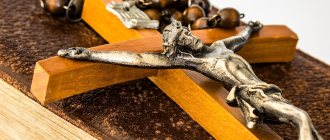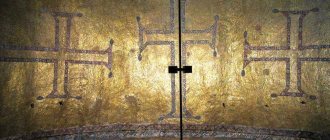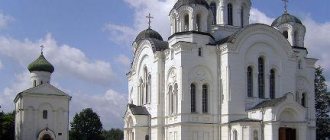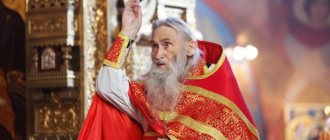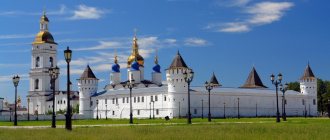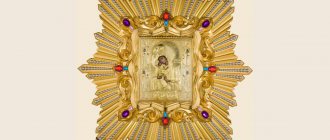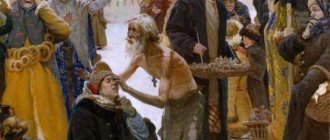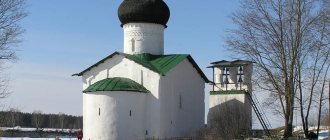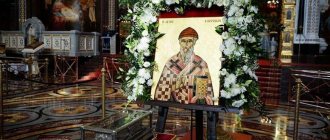The Church of St. John Chrysostom in the small village of Godenovo has become a popular place of Orthodox pilgrimage in recent years. People come to Godenovo not only from all over Russia, but also from all over the world. The reason for this is simple - it is in a small church in Godenovo that one of the main shrines of the Russian Orthodox Church, the Life-Giving Cross of the Lord, is kept. It miraculously appeared in 1423, during the most difficult time for Rus', and for almost six centuries Orthodox people have been going to this shrine in prayer.
How many tears have been shed before the Life-Giving Cross, how many fervent prayers have been said! And what is most amazing is that the Lord hears prayers said in front of this shrine in a special way. How many miracles and healings happen in Godenovo! People with cancer, whom doctors have already abandoned, are healed, infertile couples are given the opportunity to give birth to healthy children, drug addicts, who are completely immersed in this destructive passion, return to normal life, the blind receive insight, mentally ill and possessed people are healed. Many receive what they ask for in the most difficult life circumstances, when there is simply no one to expect help from. and everyone who receives what they ask for shares their miracle with their loved ones, and people come here in an endless stream - some to ask for a miracle, some to thank the Lord. Hundreds of gold jewelry fill the icon case, to which the Life-Giving Cross is located. These are offerings from grateful pilgrims, visible evidence of miracles granted by God through prayer before the Cross.
The history of the appearance of the Life-Giving Cross.
The Holy Cross was revealed not in Godenovo itself, but eight kilometers away. Now at the site of the apparition there is a monastery of the Life-Giving Cross. In 1423, according to legend, shepherds grazing cattle near the Sahota swamps once saw a bright pillar of light falling from heaven to earth. Coming closer, they saw in the bright rays of light the Cross, “descending from the sky from the Greek side.” Saint Nicholas the Wonderworker prayed next to the Cross. And the shepherds heard a voice from the Cross, commanding them to build a temple on this site, to erect a Cross, so that many who came to this great shrine could receive what they asked from God. With the blessing of the ruling bishop, Bishop Dionysius of Rostov, a wooden church was erected, consecrated in honor of St. Nicholas the Wonderworker. The news of the miracle quickly spread throughout Orthodox Rus', and pilgrims went in an endless stream through forests and swamps to bow to the Heavenly Revealed Cross. Time passed, generations changed, but people revered this shrine, and the flow of pilgrims increased every year. Before the revolution, from 4 to 5 thousand people gathered for the feast of the descent of the Life-Giving Cross, and the vestments that adorned the Cross were hung with tens of kilograms of gold and silver offerings.
Soviet times came, the temple at the site of the appearance of the Life-Giving Cross was desecrated and closed, but pious believers saved the shrine from desecration and destruction - the Cross was hidden in the Church of St. John Chrysostom in the village of Godenovo. The God-fighters came here too, but the Lord preserved His Shrine - they could neither close the temple nor destroy the Cross. But the people's memory of the Life-Giving Cross slowly faded away. As it turned out, only for a while.
Patronal holidays
Holidays celebrated in the courtyard of John Chrysostom:
- June 11 is the feast of the apparition of the Life-Giving Crucifixion;
- September 27 is the day of the erection of the Holy Cross of the Lord.
Celebrations in honor of the veneration of John Chrysostom:
- February 9 - discovery of relics by the church;
- February 12 - Cathedral of the Three Saints;
- September 27 - death of St. John.
Monastery in Godenovo.
The church in Godenovo, which had always been a parish church, since 1997 became the courtyard of the St. Nicholas Convent of Pereslavl - and life in the village of Godenovo, which was dying out in the difficult 90s, received a new breath. The sisters of the monastery came here, the tradition of daily worship and reading of the akathist before the Life-Giving Cross was revived. A road was built to the village, the temple was visited by the famous professor Vladimir Mikhailovich Kurylev, who wrote a long article about the Goden Cross. People again reached out to the shrine, and again popular rumors spread about miracles of healing and God’s obvious help through prayer at the Life-Giving Cross. and in recent years, whenever you come to Godenovo, you can always see a lot of people - these are pilgrimage groups coming here on large buses from different cities of Russia, Ukraine, Belarus, Kazakhstan, and monks who got here from distant countries - Bulgaria , Greece, Serbia. Here you can meet Orthodox people from America, Germany, England, Malta - everyone comes to venerate the great shrine. And everyone finds at the Cross what they were looking for.
Architecture, appearance
The cathedral was built like a “ship”: the church, the refectory (or vestibule) and the bell tower are on the same axis. The cubic base of the temple, with a semicircular apse adjacent to the east, has five domes and a hipped roof. What is unusual about the building is that the hipped bell tower was built directly on the roof of the vestibule.
Such an architectural solution is quite rare in Russian church architecture. The quadrangle of the temple is an almost perfect cube, the corners of which are accentuated by decorative pilasters.
The cathedral was decorated in the style of Moscow church architecture of the 15th century, as evidenced by:
- window casings;
- multi-stage gables;
- keel-shaped kokoshniks;
- triangular cornices;
- promising portals.
The middle head has a light drum, the remaining 4 drums have dull drums. The apse repeats the decorative elements of the cube. The temple is slightly weighed down by the second aisle, which was added later on the northern side of the building. The aisle is very modestly decorated, repeats the heavy convexity of the apse and has one dome. In general, the temple ensemble looks quite harmonious.
In the architecture of the bell tower, slightly cut off by the refectory, one can see a typical octagon of a belfry tent, placed on a quadruple base. In the bell tier there is some asymmetry in the arched openings: wider ones are located in the north, south, west, east, narrower ones: northwest, northeast, southwest, southeast.
The gate and fence built later fit perfectly into the temple ensemble, almost repeating the decorative decoration of the cathedral. All buildings are covered with snow-white plaster, the roof is painted with silver paint.
Miracles and healings at the Life-Giving Cross in Godenovo.
The author of these lines often travels with pilgrims to Godenovo, and over the course of several years he learned from them many cases of healings occurring at the Godenovo Cross. We'll tell you about them here.
One pilgrim signed up for a trip to Godenovo and went to the Life-Giving Cross in the spring of 2021. Several months have passed, and she signs up for a trip again, saying “I need to go, thank God.” And on the way back from Godenovo he tells his story. Before her first trip, doctors diagnosed her with laryngeal cancer. There were no prospects for a cure, the pain intensified, the tongue began to become stiff. And this woman decides to ask for help not from doctors, but from God, and goes to Godenovo. She shed many tears at the Cross and returned home in the evening. And the next morning I woke up and immediately realized that I was completely healthy! Not even traces of the terrible disease remained. The doctors just shrugged their shoulders - she no longer had any signs of cancer.
Another case was told by pilgrims from Yekaterinburg. One woman in their parish became completely blind, and the doctors could not do anything. But one of the parishioners who visited Godenovo brought her oil from the lamp burning at the Cross and water from the prayer service. The blind woman washed herself daily with this water for some time, and her vision began to return. Now she has fully received her sight, and every time someone from this parish goes to Godenovo, she is sure to bring both oil from the Cross and holy water from Godenovo to Yekaterinburg.
One of our pilgrims, upon arrival in Godenovo, took out a small paper bag with gold rings and crosses, and handed them over to decorate the Cross. She also wrote down her story in the journal of miracles performed at the Cross. For many years she was treated for infertility, but the doctors were relentless: “You will never be able to give birth to a child.” With fervent prayer, she and her husband came to the Life-Giving Cross, and a month and a half later she found out that she was pregnant. She gave birth to a beautiful girl, and when she was three years old, she collected gold jewelry and went to Godenovo. Thank God.
Contacts
The village of Godenovo is located in the Rostov district of the Yaroslavl region. You can call from 11.00 to 15.00 at +79622068215 daily, except Sunday.
Contacts:
- Address: 152130, Yaroslavl region, Rostov district, Godenovo village.
- Fax: 8 (48535) 3-06-45.
You can arrange a group excursion via email or website.
Description[edit]
From an architectural point of view, the temple in the name of St. John Chrysostom is a widespread architectural structure, considered the “calling card” of Russian religious architecture in that era when new-fangled architectural trends, which had taken root in big cities, confidently stepped into the provinces, and the provinces still equally confidently insisted on preserving traditional architectural forms. The cube, the hipped roof, the five-domed building, the hipped bell tower - everything at first glance looks like it was in the pre-Petrine era. Although the experienced eye, of course, can see that this is the most provincial 18th century. The five-domed structure is deliberately shredded relative to the total volume of the quadrangle, and is also visually reduced by narrow drums and specific, in the spirit of Russian Baroque, domes on “necks”. This is a new aesthetic - the era of the mighty Yaroslavl domes, which sometimes accounted for up to half the height of the entire temple, was becoming a thing of the past... And the bell tower’s tent is no longer the same as it was made in the 17th century. The kokoshniks alone, separated by a straight cornice, are worth something - comparable to the traditional arched end of a bell pillar, characteristic of pre-Petrine architecture. The old tents were not only an aesthetic, but also a constructive, functional continuation of the pillar. In the 18th century they had more of a decorative function. This trend will reach its apogee by the second half of the 19th century - when, during the heyday of the “pseudo-Russian” style, there will be a new surge of interest in hipped bell towers. That’s how it is, but only when compared, most of the “retrospective bell towers” of the 19th century will certainly lose in elegance to the “original bell towers” of the seventeenth century. The base of the bell tower rests on the vault of the refectory. The phenomenon is not very common in Russian architecture, but was nevertheless practiced by Rostov architects of the 18th century. Everything above the vaults is more traditional. The small quadrangle of the base turns into an octagonal pillar.
An interesting detail that is not immediately noticeable is that the arched openings of the bell tier are not equal in width: those facing strictly to the cardinal points are much wider. The altar part of the temple is a developed semicircular apse, decorated with decor that strictly repeats the decoration of the main volume, and covered with a high, as if “swollen” conch. This somewhat hypertrophied volume visibly pulls the center of gravity of the temple towards the altar part - this is especially noticeable from the northern facade. The quadrangle of the temple is almost strictly cubic in volume, the corners are accentuated by decorative blades. A perspective portal, fairly simple platbands and a cornice with “triangles” are recognizable elements of Russian architecture of the pre-Petrine era. However, there are no kokoshniks, much less zakomars - eight in a row of promising semi-circular niches between two cornices seem to hint at a belt of kokoshniks, but upon closer examination it turns out to be a prop. The gate with the fence appeared much later than the temple itself, but fit well into the overall ensemble. Their airy grace became a good architectural antithesis to the massive Bogolyubsky chapel, which somewhat “flattened” the temple across the square, “pressing” it to the ground. Being as close as possible to the western façade, the gates seem to fit into it, actively entering into the overall play of architectural volumes and verticals.
The interior of the Chrysostom Church logically breaks down into two independent volumes: the “main temple” itself and the chapel in the name of the Bogolyubskaya Icon of the Mother of God. This goes without saying. But there is also something outside the usual logic: it just so happens that the “main temple” these days is actually a secondary volume, the main attention is focused on the aisle... It’s not surprising - after all, it is in the aisle that the main Shrine is located - the Life-Giving Cross! On the other hand, the main temple is interesting for its frescoes and icons. Summer temple. Its interior volume is double-height, the walls are painted a calming soft lilac color. A large area is occupied by frescoes, made, however, not in continuous murals, but as if in the form of paintings enclosed in frames. This is a well-recognized style and technique of the 19th century: the temple, which never closed, was lucky enough to preserve the original paintings. They cover the vaults of the temple, and in the niches of the windows there are life-size images of saints. The modern fresco, gilded carved four-tiered iconostasis, made with great skill, is very good. Particularly impressive are the details of the floral ornament and the skillfully decorated royal doors, on both sides of which there are images of the Savior and the Mother of God in precious frames. The iconostasis is topped with a crucifix. In the arched passage from the refectory to the temple itself, on the wall to the right, there is a temple icon of St. John Chrysostom.
The Bogolyubsky chapel, adjacent to the main building from the north, is designed more laconically: in the center is the Life-giving Cross of the Lord, which is located to the right of the iconostasis. The altar barrier is single-tiered. There are no frescoes - the walls are covered with whitewash. Venerated ancient icons hang on the walls, among them the Bogolyubsky image of the Mother of God, John the Baptist and St. George with his life and other icons.
Temple opening hours
- For its pilgrims, the temple is open daily from 8:00 to 20:00.
- You can venerate the open feet of the Life-giving Cross of the Lord on days such as Friday, Saturday and Sunday.
- On Wednesdays, Thursdays, Fridays, Saturdays and Sundays, liturgy is celebrated here at 9 a.m., and the evening service begins at 5 p.m.
- At 8 o'clock in the morning during Great Lent, the Liturgy of the Presanctified Gifts is celebrated on Wednesdays and Fridays.
Great Shrine
In the very center of Russia, in the Yaroslavl region, near Pereslavl-Zalessky, there is one of these relics - the Life-Giving Cross. Godenovo is a small village in which the St. Nicholas convent has long existed. In his courtyard there is a temple built in honor of John Chrysostom. It was this church that became the place where in the 30s of the last century the great Life-Giving Cross found its refuge. Godenovo has seen a lot in his time. Since 1794, the domes of its five-domed temple have sparkled in the sky, and the sonorous bells have filled the entire area with crimson bells. From the day it opened, the church did not close, as if invisible forces preserved it in the era of godlessness and difficult days of revolution, wars, repressions, famine, persecution for faith and belief. Signs of antiquity are visible everywhere in the temple. Its walls were painted at the beginning of the 19th century. The skillfully made iconostasis dates back to the same time. The left side chapel of the church is consecrated with the Bogolyubskaya Icon of the Mother of God. On the right on the wall, in a special icon case, fireproof, the Life-Giving Cross is placed. Godenovo has always been very popular among pilgrims. Thanks to the relics kept here, the village is visited annually by thousands of believers and sufferers.

